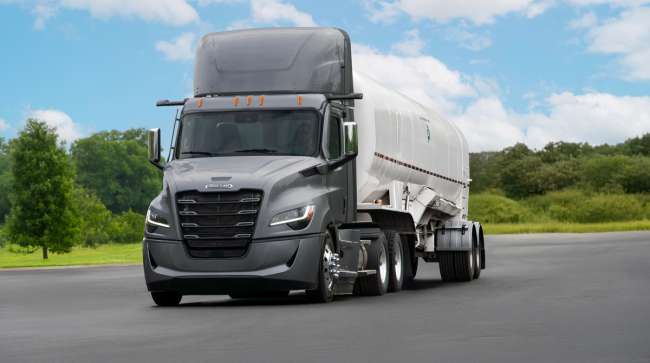Staff Reporter
Daimler Truck Q3 Profit Plunges 35% Even as DTNA Sales Gain

[Stay on top of transportation news: Get TTNews in your inbox.]
Daimler Truck profits in the third quarter of 2024 slumped 35% year over year despite an increase in North American revenue, truck sales and production.
The truck maker posted net income of $676.6 million, or diluted earnings per share of 83 cents, in Q3, down 35% from $1.033 billion, or $1.22, in the year-ago period. Headquartered in Germany, Daimler Truck reports its earnings in euros and all conversions were correct as of Nov. 7.
Daimler Truck revenue totaled $14.18 billion in Q3, down 5% from $14.96 billion in the year-ago period. The group’s global truck and bus sales in Q3 totaled 114,917 units, down 11% from 128,861 vehicles a year earlier.
“We are on track to deliver another solid year for the Daimler Truck Group in 2024. An important driver in Q3 has been our continued strong performance in North America,” newly installed CEO Karin Radstrom said in a statement.

Scherer
“Our key focus is to further increase the resilience of our business. In North America, our vocational truck strategy is paying off. Despite the weakness in the on-highway market, Trucks North America delivered another strong quarter,” added Daimler Chief Financial Officer Eva Scherer.
Daimler Truck North America sold 49,176 vehicles in the three months that ended Sept. 30, up 4% compared with 47,249 trucks and buses in the year-ago period. Of those quarterly totals, 40,971 were sold in the U.S., also up 4% from 39,530 in Q3 2023.
DTNA was able to recover from isolated bottlenecks at suppliers that affected its Q2 2024 performance, contributing to the slight Q3 increase in unit sales, its parent company said. DTNA sold 48,230 vehicles in Q2. DTNA also benefited from increased prices and lower administrative, research and development costs, it added.

Radstrom
“As mentioned in our Q2 call, this is due to two factors: first, overall demand in North America remains solid, and second, our vocational truck strategy is paying off. Vocational trucks help offset the decline in on-highway volumes. We have reduced our dependence on the on-highway market and therefore increased our resilience,” Radstrom said during a Nov. 7 call with analysts.
Incoming orders at DTNA totaled 36,837 vehicles in the three months that ended Sept. 30, up 4% from 35,269 in the same period 12 months earlier.
DTNA produced 48,527 trucks and buses in Q3, up 4% compared with 46,812 vehicles in the year-ago period.
The company’s estimated share of Class 8 sales in the most recent quarter across the U.S., Canada and Mexico was 39.2%, compared with 38.6% a year earlier. In Classes 6 and 7, the company estimates its market share was 32.2%, down 2.9 percentage points from 35.1% in the year-ago period.
We just released our Q3 results. 🚚🚛🚌
Press release: https://t.co/vHwrI7odEg#DaimlerTruck #DTR0CK — Daimler Truck (@DaimlerTruck) November 7, 2024
DTNA posted a 5% increase in revenue to $6.46 billion in Q3 from $6.17 billion 12 months earlier. DTNA’s return on sales in the most recent quarter was 12%, compared with 12.5% a year earlier.
Scherer said DTNA’s margins fell as the mix of truck sales shifted toward vocational trucks, noting that the company’s Western Star brand is “still in the ramp-up phase” with its vocational lineup. As a result, she said the company is still optimizing the cost structure for that unit. Plus, she noted customer use of Daimler’s in-house Detroit engine was lower in vocational than in the on-highway sector.
Customer adoption of Detroit engines for North America’s best-selling semi, Freightliner’s Cascadia model, is around 90%. Freightliner launched a fifth-generation Cascadia on Oct. 15 after publicly showcasing its flagship tractor for the first time at American Trucking Associations’ Management Conference & Exhibition.
Looking forward, Daimler Truck maintained its 2024 North American heavy-duty truck market forecast of 280,000 to 320,000 trucks. The forecast encompasses the U.S., Canada and Mexico. The company’s expectations from DTNA’s share of those sales are also unchanged at 180,000-200,000 trucks.
Host Seth Clevenger and Features Coordinator Mike Senatore take you behind the scenes to unveil the 2024 Top 50 Global Freight Companies. Tune in above or by going to RoadSigns.ttnews.com.
Further down the line, Daimler Truck remains optimistic about DTNA’s options even if President-elect Donald Trump increases tariffs on imports from Mexico, as he has threatened.
“It is too early to speculate about the impact of the election results on our business,” Radstrom said, but she added: “We have a lot of flexibility when it comes to our production footprint in the U.S. and in Mexico.”
DTNA operates six production plants in the U.S. The company can build every truck and bus model it offers at its U.S. facilities, said the company’s top executive.
“There is no dependence for a particular model on Mexico,” Radstrom said.
However, sales elsewhere in the world continued to disappoint. Mercedez-Benz Trucks sold 28,688 vehicles in the most recent quarter, down 28% from 40,077 a year earlier, with sales in its home market of Germany down 50%. Asian truck sales fell 15% year on year to 32,245 from 38,052.
In late October, Daimler Truck said it was reassessing the prospects of its operations in China. The company took a 180 million euro ($194 million as of Nov. 7) write-down on the value of its Chinese operations in Q3 after taking a 120 million euro charge against its Q2 earnings. In August, the company cut its 2024 guidance as a result of Chinese and European market weakness.
The company’s full-year guidance for 2024 remains unchanged at sales of 460,000 to 480,000 truck and bus sales and revenue of $57.18 billion to $59.33 billion.
Want more news? Listen to today's daily briefing below or go here for more info:





